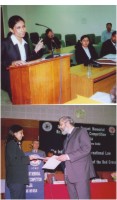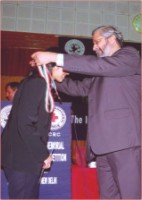Feature
History of the moot court
Rezaur Rahman
 A Moot court is a competitive extracurricular activity in many law schools where participants take part in simulated court proceedings. The student teams prepare and argue legal cases, which can be real or hypothetical. The cases are pertaining to current issues, sometimes mimicking an actual case and sometimes fabricated to address difficult legal issues. The cases are decided on before the competition. Participants will typically receive a problem case ahead of time, which includes the facts of the underlying case. Teams are assigned opposing sides. They must then research and prepare for that case as if they were lawyers for one or sometimes both parties. Depending on the competition, participants are required to submit written briefs, participate in oral arguments, or both. Legal practitioners with expertise in that particular area of law serve as judges in the competition. A Moot court is a competitive extracurricular activity in many law schools where participants take part in simulated court proceedings. The student teams prepare and argue legal cases, which can be real or hypothetical. The cases are pertaining to current issues, sometimes mimicking an actual case and sometimes fabricated to address difficult legal issues. The cases are decided on before the competition. Participants will typically receive a problem case ahead of time, which includes the facts of the underlying case. Teams are assigned opposing sides. They must then research and prepare for that case as if they were lawyers for one or sometimes both parties. Depending on the competition, participants are required to submit written briefs, participate in oral arguments, or both. Legal practitioners with expertise in that particular area of law serve as judges in the competition.
Webster's New Riverside Dictionary (1984 ed.) defines 'moot' as “an ancient English meeting, especially a representative meeting of freemen of a Shire” and a “hypothetical case argued as an exercise by law students”. In Black's law dictionary the term “moot court “is defined as a “mock court where hypothetical cases are tried for the training of law students”. Thus at times the term “moot court” is confused with “mock trial” or “mock court”. However the two are not the same. “Moot court” usually refers to mock appellate court, while “mock trial” usually refers to a simulated jury trial or bench trial. In the Great Britain and commonwealth countries the phrase 'moot court' may be shortened to simply 'a moot' and the activity may be called 'mooting'. It is like debate, except that in moot court you cannot state any argument without supporting documents.
 HISTORY OF THE MOOT COURT: HISTORY OF THE MOOT COURT:
The first reference to a moot is found in the law of Ethelred the Unready published in 997. Researching the origin of the jury trial Pollock and Maitland (both prominent jurists) discovered the Danish law which requires a “moot is to be held every weekend”, and discusses how the twelve eldest “things are to go out with the reeve and to swear upon the relic that he puts into their hands that they will accuse no innocent and conceal no guilty man”. Pollock seems to believe that while this certainly does look like a jury of accusation, the context makes him doubt whether this is a law that was generally in effect or that continued in effect intact down to the present day. However it is the first recorded use of the word moot in a legal context. The first written reference of mooting that offers an explanation of the origin of our present day moot court surfaces in Robert Pearce's guide to the Inns of Court and Chancery. Pearce indicates that moots were common practice in England in the late 14th century. The title page of Pearce's book reads
“A guide to the Inns of court and Chancery with notices of their ancient discipline, rules, orders and customs, reading, moots, masques, revels and entertainments…”
 Following is an accurate, detailed description of mooting from the early 1800's: Following is an accurate, detailed description of mooting from the early 1800's:
“Another sort of exercise in the Inns of court were called moots, from the Latin word for move, to move or debate of cases. These moots were usually performed by students of a certain standing, preparatory to their commencing practice. Moot men in Lord Coke's time were those who argued readers' cases in house of chancery, both in terms and grand vacations. Of mootmen, after eight years 'study, were chosen utter Barristers…”
In 1824, Lord Justice Atkin of Gray's Inn wrote that the practice of mooting was an ancient and essential part of the legal training necessary for call to the Bar. There were very few attempts in 18th century to revive the original significance and form of the old reading and moots. It is late in the nineteenth century that we begin to see reforms in this area of education for students intending to enter the legal profession. “When formal legal education began in the United States in the late 18th and early 19th centuries, it was very similar to that of the Inns of Court”. There were lectures by professors followed by moot court exercises. Harvard law school approved student-run moot court programs in 1910, utilizing a board of third year students. It is virtually impossible to mention an American, European or British law school that does not presently include moot court competitions as a viable part of their curriculum.
 Moot court can be done in many ways, including head to head competition and tournament formats. Some moot court organizations accept a small group of people for membership and these members participate in a number of national or regional moot court competitions. Other schools accept a large number. Moot court competitions are typically sponsored by organizations with interest in one particular area of law, and the moot court problems address an issue in that field. This competition is conducted following the procedures of International Criminal court (ICC) or the United Nation's most important legal organ, the International court of Justice (ICJ). Moot court can be done in many ways, including head to head competition and tournament formats. Some moot court organizations accept a small group of people for membership and these members participate in a number of national or regional moot court competitions. Other schools accept a large number. Moot court competitions are typically sponsored by organizations with interest in one particular area of law, and the moot court problems address an issue in that field. This competition is conducted following the procedures of International Criminal court (ICC) or the United Nation's most important legal organ, the International court of Justice (ICJ).
MOOT COURT PERSPECTIVE IN BANGLADESH:
Moot court is not familiar in our country but the faculty of law, Dhaka University and International Committee of the Red Cross (ICRC) jointly organized The National Henry Dunant Memorial Moot Court Competition in Dhaka University. They have already arranged Two Moot Court Competitions. The National Henry Dunant Memorial Moot Court Competition is an annual competition that has been in existence since 2005 and is sponsored by the International Committee of the Red Cross (ICRC). It is a one-day competition based upon oral argument only (no written briefs). Several different universities compete in this Moot Court, and each department is allowed to send up to three persons in a team. Each teams consists of two counsels (who pleaded before the judges) and one researcher The Competitions are judged by eminent judges, legal practitioners with expertise in the particular area of law, and sometimes by sitting judges. The judges evaluate the teams' performance and judge the best team. They also decide on the best presenter. The qualified teams are selected for the regional round to be held in Delhi where they compete with other teams from India, Nepal, Srilanka, Pakistan and Iran. This competition is a very hard job for the Bangladeshi students, but in the last competition the students from Dhaka University defeated all the teams.
Some of the basic rules are:
Petitioners, the side bringing the case, go first. They have a set time, usually an hour, to present their case. They may, if they choose, request five minutes for a reply at the close of the respondents' arguments. Each person on the team gets the same amount of time. If an individual presenter does not use all of his or her time, that time is forfeited. Presenters have a set time for their argument. During this time, they may use notes and other materials, but they may not receive help from any other person. They should begin their arguments with, "If it may please the court, I am (mention his name) and I am representing the petitioners". Judges may ask questions at any time. They may ask anything about the case, and are not restricted to the point or argument the presenter is making at the time. After the petitioners, the respondents have the same time period to present their argument. Respondents do not, however, get a reply. At the close of the arguments, the judges meet to deliberate. They generally make three decisions:
(a) Judgment of case based on merits---which side should prevail legally
(b) Best Overall Team
(c) Best Individual Presenter
It is a great practice for legal students in preparation for their future legal careers. There is no substitute for the experience of actually making a legal argument before an actual judge. It helps develop important skills needed for both law school and real practice. These skills included the ability to communicate effectively, think analytically, understand key legal principles and construct a sound legal argument. It also enriches a student's curriculum vita and is very enjoyable.
Dept.of law
Dhaka University
| 